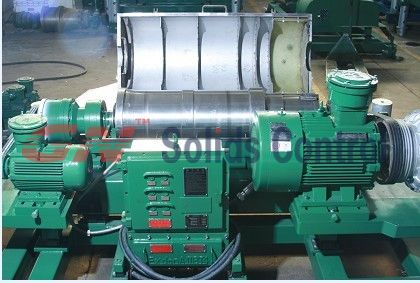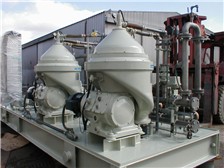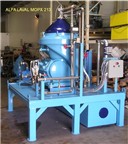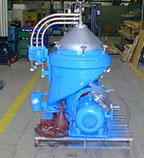Algae industry awash in new technologies to address key commercialization barrier: will they pluck algae, and the algae industry, out of the water?
Last month in the Digest we ranked “Algae extraction” at #5 on the list of “Transformers” – technologies that would rock the bio world. We wrote:
“While we are on the subject of the special challenges of growing algae, there’s the problem of getting the algae out of the water, or the water out of the algae. Given that a decent microalgae concentration is around 0.1 percent, you have to remove 1000 gallons of water per gallon to get a gallon of dry algal biomass, which has about 50,000 BTUs or so. So even if you are expending just a handful of BTUs per gallon to move the water, you’re dangerously close to using more energy to produce algal fuels than the fuel contains…For sure, no algae fuel company will emerge at scale without a solution to this one."
It’s true. You have to have this one solved. It’s mandatory. But the field s full of contenders now – in fact, half the problem is figuring out which technology to partner with. They are popping up these past twelve months at a rate of around one technology every sixty days – three new ones since mid January, as a matter of fact.
That’s, in part, the rational for the National Algae Association to hold an Algae Growing, Harvesting, Extraction Technologies and Networking Conference, this week in Fairless Hills, Pennsylvania. For those who won’t have a chance to network at the NAA meeting, we have this state of the art review.
Three new contenders
AER Sustainable Energy – enzymatic hydrolysis
This Ireland-based group, set up in 2006, applied for license to supply ethanol into the Irish market, and by 2010 was supplying up to 25 percent.
The company reinvested a good portion of the profits with University of Galway R&D enzyme technology, under development since 2000 for 3G sustainable algae. Funded research, and had a technology to extract oil and sugars from high yielding strain.
It’s billed as a cheap, efficient extraction process from a company that’s “ruthlessly focused on a technology, elegant and simple, that breaks down the cell wall to release the oils and sugars,” according at AERS CEO Donal Mac Nioclais.
“The Idea of trying enzymatic hydrolysis with algae is not new, but this is a modified organism, specifically optimized for this problem – to lyse the cell wall. Isn’t that the story of technology? First you have the generics, then the customized solutions.” Mac Nioclais said that “we’re not competing with the likes of Novozymes, we’re targeted.”
One of the juggling acts in the space? Timing your development pace so that you don’t arrive ahead – or too far behind – the algal growth companies. “There’s a 3-5 year program in terms of algal development,” said Mac Nioclais, “some are behind and some ahead of that curve. We’re developing an enabling technology for an industry not yet there, that’s the risk, but there are large, existing markets for nutraceuticals.”
The company is staying in stealth mode as far as its customer list, saying only that it is “working with multiple large international companies on contract R&D to develop solutions for various strains.”
Diversified Technology – pulsed electric field (PEF) technology
In February, Diversified Technologies’ announced that they have introduced low-cost process (patent pending) for the pre-treatment of algae using pulsed electric field (PEF) technology to streamline the extraction of oils from algal cells early in the biorefining process. The PEF applies 10-30 kV/cm electric pulses for 2 to 20 microseconds to an algal slurry which rupture the cell walls to release biodiesel compounds such as methyl hexadecanoate.
Diversified estimates this low energy process of lysing algae cells would account for about $0.10/gal. of the price of algae-derived biofuel compared to $1.75/gal. for conventional drying.
Aurora Algae — amphyphillic solvents
Last month, we learned a little more about Aurora’s dehydration and lipid extraction system, when they received US patent 7,868,195 for “Systems and Methods for Extracting Lipids from and Dehydrating Wet Algal Biomass”.
In traditional approaches, operators have attempted to dehydrate the algae, then separate lipids from the protein. In Aurora’s approach, they take the view that the goal should not be to get the algae out of the water, or the water out of the algae, but separate the protein and carbs from the water and lipid soup.
Not to oversimplify, but amphyphillic solvents that attract both water and lipids can do this work – its one of the principles behind your friend, the soap bar.
Aurora, according to their patent, propose to strain or centrifuge the algae to reach a 10-40 percent concentration, then use a solvent such as acetone, methanol, ethanol, isopropanol, butanone, dimethyl ether, or propionaldehyde to separate out the proteins and carbs from the lipids. After recovering the solvent, water and lipids are separated out as easily as, well, oil and water.
7 technologies also in development and deployment
Algaeventure Systems and low-energy solid-liquid separation system
Last January in Ohio, Algaeventure Systems released an RFP targeting the nation’s leading algae producers to act as demonstration sites for its SLS Industrial algae dewatering technology under its 2009 DOE ARPA-E grant.The RFP is an opportunity for AVS and potential demonstration sites to test and evaluate an innovative technology on a large-scale, under real-world conditions.
AVS will consider demonstration sites across a range of algae growth configurations and will select sites based upon production output, type of growth system, algae species and regional location. Described by ARPA-E as a “potentially transformative innovation…of the very highest scientific and technical merit,” the low-energy solid-liquid separation system aims to reduce the energy cost of dewatering microalgae by 90%.
AlgaeVenture Systems reported in 2009 that a prototype of its technology has reduced algae dewatering costs to $1.92 per ton (about $0.007 per gallon), from a $3.19 per gallon cost achieved with centrifuges and will reduced the cost from $875 per ton to a dramatic low cost of $1.92 per ton.
OriginOil’s Single-Step Extraction and Live Extraction
OriginOil’s Single Step Extraction is currently implemented in the field at MBD Energy’s James Cook University site in North Queensland, Australia. It can be deployed in two ways: dewatering only for conversion of the entire algae mass to a refinable bio-oil, or full separation of lipids and biomass to create more valuable products along with fuels.
Live Extraction is OriginOil’s process for extracting very high quality lipids on a continuous basis from algae that heals after it has been ‘milked’ of its oil content. Live Extraction is in a prototype stage and further developments are expected in 2011.
In January, the company announced that it will focus on its algae extraction technology platform to the exclusion of a number of other technologies for, among other things, algal growth.
New Oil Resources and thermal depolymerization.
Last October, New Oil Resources announced that it has developed a process that uses hot, pressurized water to treat the biomass in a process commonly referred to as hydrothermal liquifaction or thermal depolymerization.
According to the research team, “algae can be processed without dewatering and all the carbon is converted to fuels, not just the fatty oils.” The group said that immediate applications include processing municipal sewage sludge, processing waste streams from the ethanol industry and converting algae to fuel.
The Newoil process is reporting that 70% to 80% of the energy in the feedstock is being returned in the final products. The remaining 20% to 30% of the energy is used to run the process.
Unitel and its sweetwater slurry
Last July, Unitel Technologies advised that the company has filed a patent application for a new technology for making biofuels from microalgae. The process involves minimal dewatering, and completely bypasses the energy intensive drying and oil extraction steps.
In the Unitel process, the feedstock – a slurry or “soup” of water and cultivated algae (1% to 20% by weight) is continuously treated in a special hydrolysis reactor to yield 1) a fatty acid product, 2) a “sweet” water stream containing glycerol and other solubles, and 3) deoiled algal biomass. A small fraction of the fatty acid product is fed back into the reactor as catalyst.
The nutrient rich “sweet water” is recycled into the algae propagation tanks, where the carbon in the glycerol serves to promote the growth of phytoplankton.
The de-oiled biomass (consisting primarily of proteins and carbohydrates) is dried as a food ingredient for animal consumption. The algal fatty acid product is catalytically decarboxylated and converted into paraffinic hydrocarbons (alkanes), followed by mild hydrocracking and hydroisomerization to make biojet fuel comprised of C10-C15 branched paraffins.
Evodos and low-cost centrifuging
A year ago last September, Evodos said that it had developed a very energy-efficient centrifuge to extract algae from water. The low energy consumption allows for a positive energy balance, paving the way for large-scale production of biodiesel from algae, according to company reports. Leading scientists are very excited about this innovation.
The Evodos technology consists of two steps: first, most of the water in which the algae are growing is removed and next the algae are transformed into a dry paste. The Evodos technology enables the extraction of a solid algae cake with a dry solid content of 31.5%. Tests have been conducted to date with Nannochloropsis.
The University of Michigan’s big algal bypass
Last September, a UM research team published, in Energy & Fuels, details of a two-step, catalyst-free algal biodiesel production process, using wet algal biomass and bypassing the drying and solvent extraction steps.
The researchers wrote: “In the first step, wet algal biomass (ca. 80% moisture) reacts in subcritical water to hydrolyze intracellular lipids, conglomerate cells into an easily filterable solid that retains the lipids, and produce a sterile, nutrient-rich aqueous phase. In the second step, the wet fatty acid-rich solids undergo supercritical in situ transesterification (SC-IST/E) with ethanol to produce biodiesel in the form of fatty acid ethyl esters (FAEEs).”
The University of Michigan’s pressure-cookin’, bio-oil makin’ recipe for makin’ money from low-fat algae
In Michigan, researchers at the University of Michigan are investigating a recipe to pressure-cook algae at 300 degrees for 30 minutes, and thereby break down oils, proteins and carbohydrates into a bio-oil, which can be upgraded into fuel.
The $2 million project, funded by the National Science Foundation under the American Recovery and Reinvestment Act, is aimed at producing acceptable fuel yields from low-oil content algae strains, as well as eliminating the need for water extraction in algal fuel production.
Plus, 5 stealthy or embryonic projects to keep an eye on.
New Mexico State and the Air Force
The US Air Force has granted New Mexico State University $2.364 million towards algal research to study better ways to grow algae and refine its oil while working with the University of Central Florida to determine the effects of algae-based fuel on jet engines.
A mystery at Heliae
In November, Heliae tapped ex-BioFuel Energy COO Dan Simon as CEO. Simon says that Phoenix-based Heliae, which just opened a state-of-the-art research and development facility located in Gilbert, is undertaking scaled testing of a patent-pending extraction process that they can’t say anything about. One to watch even if we don’t know a darm thing about it.
Solix and the sonic option
Noise usually destroys concentration, but turns out that a team from the Los Alamos National Laboratory went the other way on that. According to reports that came out at the time Solix signed a research agreement with LANL, “Los Alamos’ acoustic-focusing technology generates ultrasonic fields that concentrate algal cells into a dense sludge and extract oil. Solix hopes that combining the concentration and extraction steps into one process will eliminate the need for centrifuges and solvents (traditional extraction methods) — and at the same time, significantly cut the cost of producing the biofuel.”
Over at the National Alliance for Advanced Biofuels and Bioproducts (NAABB)
Led by the Donald Danforth Plant Science Center (St. Louis, MO), NAABB is integrating resources from companies, universities, and national laboratories to overcome the critical barriers of cost, resource use and efficiency, greenhouse gas emissions, and commercial viability. They landed a $50M foundational grant from the DOE last year, and have been gearingup on a variety of research fronts.
Principal investigator of the NAABB project, Jose Olivares, said: “In harvesting and oil extract, we are starting with five technologies and hop to focus down to one or two for harvesting the algae in a very energy efficient manner, and that are very cost effective.”
Aquatic Energy
In Louisiana, a project from the Louisiana-AgCenter and Aquatic Energy has been recommended for state research funds by the Industrial Ties Research Subprogram (ITRS) component of the Board of Regents Support Fund. These funds have been endorsed for their proposal to develop breakthrough technology for harvesting microalgae from liquid cultures with the goal of drastically reducing harvesting and dewatering costs.
source: biofuelsdigest.com













